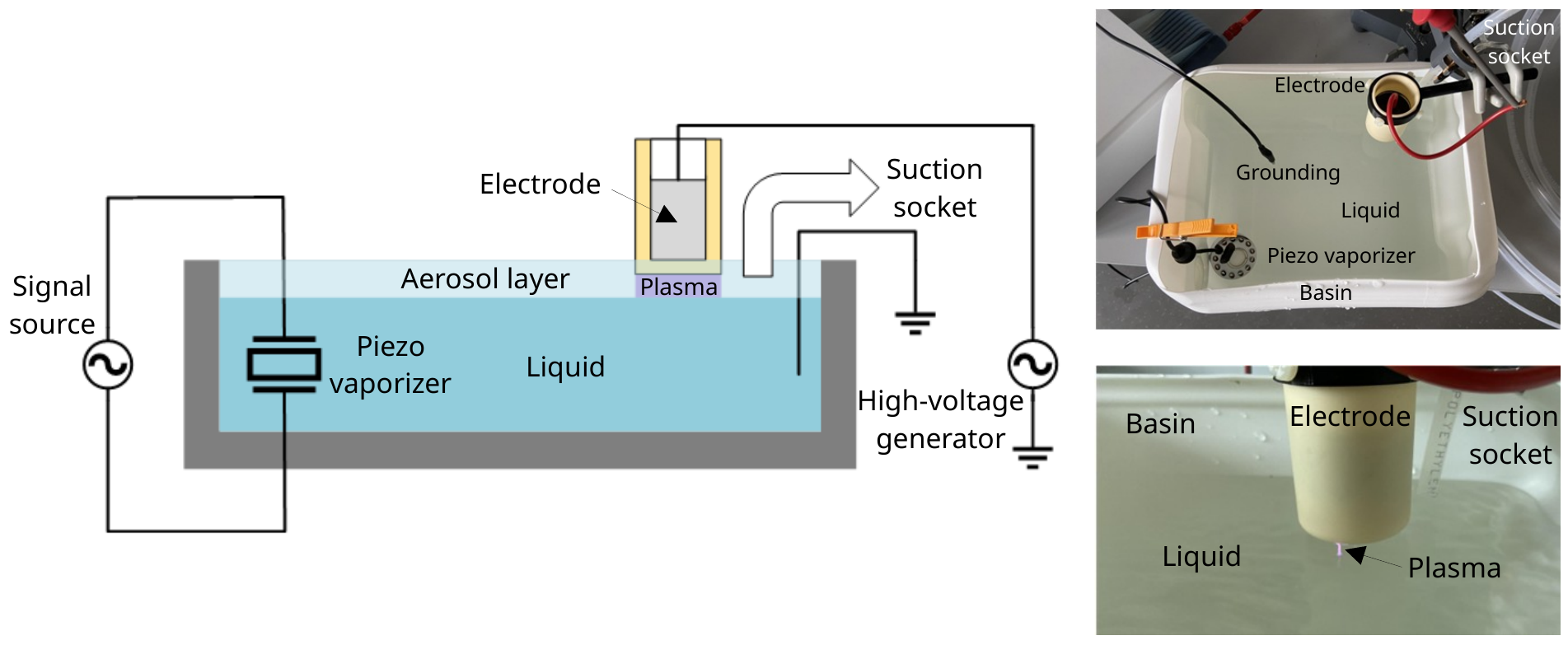
Efficient generation of plasma-activated aerosols
Solutions for an efficient generation of plasma-activated aerosols with high activities are suggested. A cold plasma is ignited directly in the presence of sprayed liquid droplets, leading to intercalation of reactive species on the surface or in the volume of droplets.
Challenge
Plasma-activated water (PAW) is well known for its antimicrobial properties and is distinguished as a relatively cheap source for decontamination or disinfection applications. Production of PAW usually involves the generation of reactive oxygen and nitrogen species, which are partly dissolved in water and also react with water to form further reactive species. The process leads to a change of the pH value, redox potentials and electrical conductivity of water. Devices and methods for the generation of plasma-activated aerosols are also available. They can be based on spraying liquids into a droplet fog and guiding it through a plasma, which is generated by a dielectric barrier discharge (DBD). However, the generation of highly and long-term active, plasma-activated aerosols with high efficiencies and broad application suitability can be very challenging.
Our solution
Scientists from the University of Applied Sciences and Arts – Hildesheim/Holzminden/Göttingen have developed efficient methods for the generation of plasma-activated aerosols, which exhibit high activities. According to the invention, a liquid is sprayed in the presence of a process gas into an aerosol and a DBD (non-thermal plasma) is generated in the presence of the aerosol. This leads to the formation of reactive species, which are directly enclosed on the surface or in the volume of the aerosol droplets. Hence, the present process, which is also related to the ignition of a cold plasma directly within the aerosol, leads to plasma-activated liquid droplets in the size range of 1 – 100 µm (preferentially 10 µm). The spraying of the liquid can be performed with a piezo actuator, while the DBD is carried out at atmospheric pressure (~ 1 x 10⁵ Pa). After DBD the aerosol exhibits a temperature of 5 – 35°C (preferentially 15 – 25°C). A buffer solution (e.g. Tris) with pH values ranging from 7 – 9 can be used as liquid, in order to provide a neutral, plasma-activated aerosol product. Besides water, the liquid can contain pharmaceuticals as well. According to one embodiment, a plasma-activated aerosol layer can be generated in the vicinity of a liquid surface in a liquid basin (see Fig. 1). The plasma-activated aerosol can be extracted with an exhaust port and directly transferred for inhalation.
 Fig. 1: Setup for generation of plasma-activated aerosol from a liquid basin (source: University of Applied Sciences and Arts - Hildesheim/Holzminden/Göttingen).
Fig. 1: Setup for generation of plasma-activated aerosol from a liquid basin (source: University of Applied Sciences and Arts - Hildesheim/Holzminden/Göttingen).
Fig. 2 shows another embodiment of the present invention. Plasma is activated by applying a high voltage between two electrically shielded electrodes. A piezo vaporizer or spray nozzle, which is positioned onto a sponge, textile or fibers saturated with liquid, is switched in series with the electrodes. The piezo element produces an aerosol stream, which is directly guided to the region of DBD and plasma generation. This leads to the formation of a plasma-activated aerosol, which can be extracted directly for inhalation.
 Fig. 2: Setup for generation of plasma-activated aerosol from a moist sponge (source: University of Applied Sciences and Arts - Hildesheim/Holzminden/Göttingen).
Fig. 2: Setup for generation of plasma-activated aerosol from a moist sponge (source: University of Applied Sciences and Arts - Hildesheim/Holzminden/Göttingen).
Advantages
- Efficient generation of stable, plasma-activated aerosols
- Flexible and cost-efficient setups in combination with direct utilization of the aerosol product
Applications
- Medical applications (e.g. decontamination, disinfection and inhalation therapy)
- Agricultural sector (e.g. basic agricultural production)
Development Status
The generation of plasma-activated aerosols has been successfully developed on laboratory scale. Proof of concept shown.
Patent Situation
German patent application: DE102021215058A1
International patent application filed: WO2023126416A1
Patent applicant: University of Applied Sciences and Arts - Hildesheim/Holzminden/Göttingen
Contact
Dr. Mirza Mackovic
Patent Manager Technology
E-Mail: Diese E-Mail-Adresse ist vor Spambots geschützt! Zur Anzeige muss JavaScript eingeschaltet sein!
Phone: +49 551 30724 153
Reference: CPA-2200-HAWK
Tags: Plasmaphysik
